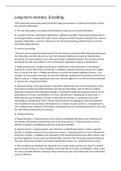Summary
Summary LONG TERM MEMORY
- Course
- PSY100
- Institution
- University Of Toronto (U Of T )
Its a detailed summary of books and lectures about the topic long term memory and contains additional examples and simple use of scientific terms/ language .
[Show more]



